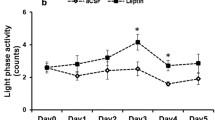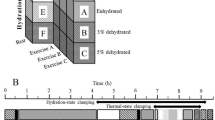Abstract
Previous studies have shown that aminophylline, a phosphodiesterase inhibitor (thereby increasing intracellular cyclic AMP concentration) elicits supramaximal heat production and improves cold tolerance in rats acclimated to 22°C. To test whether aminophylline-stimulated supramaximal thermogenesis is independent of both the thermogenic capacity (i.e. aerobic fitness) and the mode of thermogenesis (shivering vs. non-shivering), rats (adult male Sprague-Dawley, approximately 400 g) of two different ages (4–11 month and 9–17 month, n=12 for each) were acclimated to 5, 15, and 25°C in succession and their thermogenic responses to aminophylline subsequently assessed. Aminophylline elicited supramaximal thermogenesis and improved cold tolerance regardless of age or acclimating temperatures. Further, the absolute net increase in heat production stimulated by aminophylline was also similar for all acclimating temperatures. After acclimating to 15°C, a single injection of aminophylline in the older rats elicited thermogenesis greater than that of the controls acclimated to 5°C; in the younger rats, aminophylline duplicated 46% of the increase in thermogenesis observed after acclimating to 5°C. These results indicated that the aminophylline-stimulated extra heat production is independent of both the thermogenic capacity and the mode of thermogenesis. It is possible that an enhanced substrate mobilization consequent to increased intracellular cyclic AMP concentration by aminophylline underlies the common mechanism via which supramaximal thermogenesis is elicited in temperature-acclimated rats.
Similar content being viewed by others
References
BERTIN, R. and PORTET, R. (1975): 3′, 5′-Cyclic-AMP phosphodiesterase activities in white and brown adipose tissues of cold-acclimated rats. Can. J. Biochem., 53: 1301–1308.
BURNS, T. W., BOYER, P. A., TERRY, B. E., LANGLEY, P. E., and ROBINSON, G. A. (1979): The effect of fasting on the adrenergic receptor activity of human adipocytes. Lab. Clin. Med., 94: 387–394.
CANNON, B. and NEDERGAARD, J. (1983): Biochemical aspects of acclimation to cold. J. Therm. Biol., 8: 85–90.
CHAFFEE, R. R. J. and ROBERTS, J. C. (1971): Temperature acclimation in birds and mammals. Ann. Rev. Physiol., 33: 155–202.
DEPOCAS, F. (1962): Body glucose as fuel in white rats exposed to cold: results from fasted rats. Am. J. Physiol., 202: 1015–1018.
DESAUTELS, M., ZAROR-BEHRENS, G., and HIMMS-HAGEN, J. (1978): Increased purine nucleotide binding, altered polypeptide composition and thermogenesis in brown adipose tissue mitochondria of cold-acclimated rats. Can. J. Biochem., 56: 378–383.
EXTON, J. H., LEWIS, S. B., HO, R. J., and PARK, C. R. (1972): The role of cyclic AMP in the control of heptic glucose production by glucagon and insulin. In: Advances in Cyclic Nucleotide Research. P. Greengard, G. A. Robinson and R. Paoletti (eds.), Raven, New York, 91–101.
FOSTER, D. O. and FRYDMAN, M. L. (1979): Tissue distribution of cold-induced thermogenesis in conscious warm- or cold-acclimated rats reevaluated from changes in tissue blood flow: The dominant role of brown adipose tissue in the replacement of shivering by nonshivering thermogenesis. Can. J. Physiol. Pharmacol., 57: 257–270.
FOSTER, D. O., FRYDMAN, M. L., and USHER, J. R. (1977): Nonshivering thermogenesis in the rat. I. The relation between drug-induced changes in thermogenesis and changes in the concentration of plasma cyclic AMP. Can. J. Physiol. Pharmacol., 55: 52–64.
HART, J. S. (1971): Rodents. In: Comparative Physiology of Thermoregulation. G. C. Whittow (ed.), Academic Press, New York, 1–149.
HEIM, T., SCHENK, H., WAGNER, H., WINKLER, L., GOETZE, E., and VARGO, F. (1974): In vivo metabolism of 14C-labeled palmitic acid in serum and in brown and white adipose tissues of well-fed and starved newborn rabbits. Biol. Neonat., 24: 244–255.
HIMMS-HAGEN, J. (1967): Sympathetic regulation of metabolism. Pharmacol. Rev., 19: 367–461.
JOURDAN, M. L., WANG, L.C.H., and CHRISTOPHERSON, R. J. (1984): Effects of fasting and aminophylline on norepinephrine-stimulated non-shivering thermogenesis. Life Sci., 34: 1101–1109.
LANDSBERG, L. and YOUNG, J. B. (1978): Fasting, feeding and regulation of the sympathetic nervous system. N. Engl. J. Med., 298: 1295–1301.
MUIRHEAD, M. and HIMMS-HAGEN, J. (1971): Changes in the amount and properties of adenyl cyclase in brown adipose tissue during cold-acclimation of rats to cold. Can. J. Biochem., 49: 802–810.
MUIRHEAD, M. and HIMMS-HAGEN, J. (1974): Changes in the adenyl cyclase system of skeletal muscle of cold-acclimated rats. Can. J. Biochem., 52: 176–180.
MUIRHEAD, M., INGLIS, A., and HIMMS-HAGEN, J. (1974): Urinary excretion of cyclic AMP by cold-acclimated rats. Can. J. Biochem., 52: 404–417.
NICHOLLS, D. J. (1979): Brown adipose tissue mitochondria. Biochim. Biophys. Acta 549: 1–29.
SWINYARD, E. A. (1980): Respiratory drugs. Remington's Pharmaceutical Sciences. A. Osol. (ed.), Mack, Easton, PA, 809–814.
WANG, L. C. H. (1978): Factors limiting maximum cold-induced heat production. Life Sci., 23: 2089–2098.
WANG, L. C. H. (1980): Modulation of maximum thermogenesis by feeding in the white rat. J. Appl. Physiol.: Respirat. Environ. Exercise Physiol., 49: 975–978.
WANG, L. C. H. (1981a): Effects of fasting on maximum thermogenesis in temperature-acclimated rats. Int. J. Biometeor., 25: 235–241.
WANG, L. C. H. (1981b): Effects of feeding on aminophylline induced supramaximal thermogenesis. Life Sci., 29: 2459–2466.
WANG, L. C. H. and ANHOLT, E. C. (1982): Elicitation of supramaximal thermogenesis by aminophylline in the rat. J. Appl. Physiol.: Respirat. Environ. Exercise Physiol., 53: 16–20.
WANG, L. C. H. and PETER, R. E. (1975): Metabolic and respiratory responses during Helox-induced hypothermia in the white rat. Am. J. Physiol., 229: 890–895.
WANG, L. C. H. and PETER, R. E. (1977): Changes in plasma glucose, FFA, corticosterone, and thyroxine in He-O2-induced hypothermia. J. Appl. Physiol.: Respirat. Environ. Exercise Physiol., 42: 694–698.
Author information
Authors and Affiliations
Rights and permissions
About this article
Cite this article
Wang, L.C.H. Supramaximal heat production induced by aminophylline in temperature-acclimated rats. Int J Biometeorol 29, 37–46 (1985). https://doi.org/10.1007/BF02189004
Received:
Issue Date:
DOI: https://doi.org/10.1007/BF02189004




